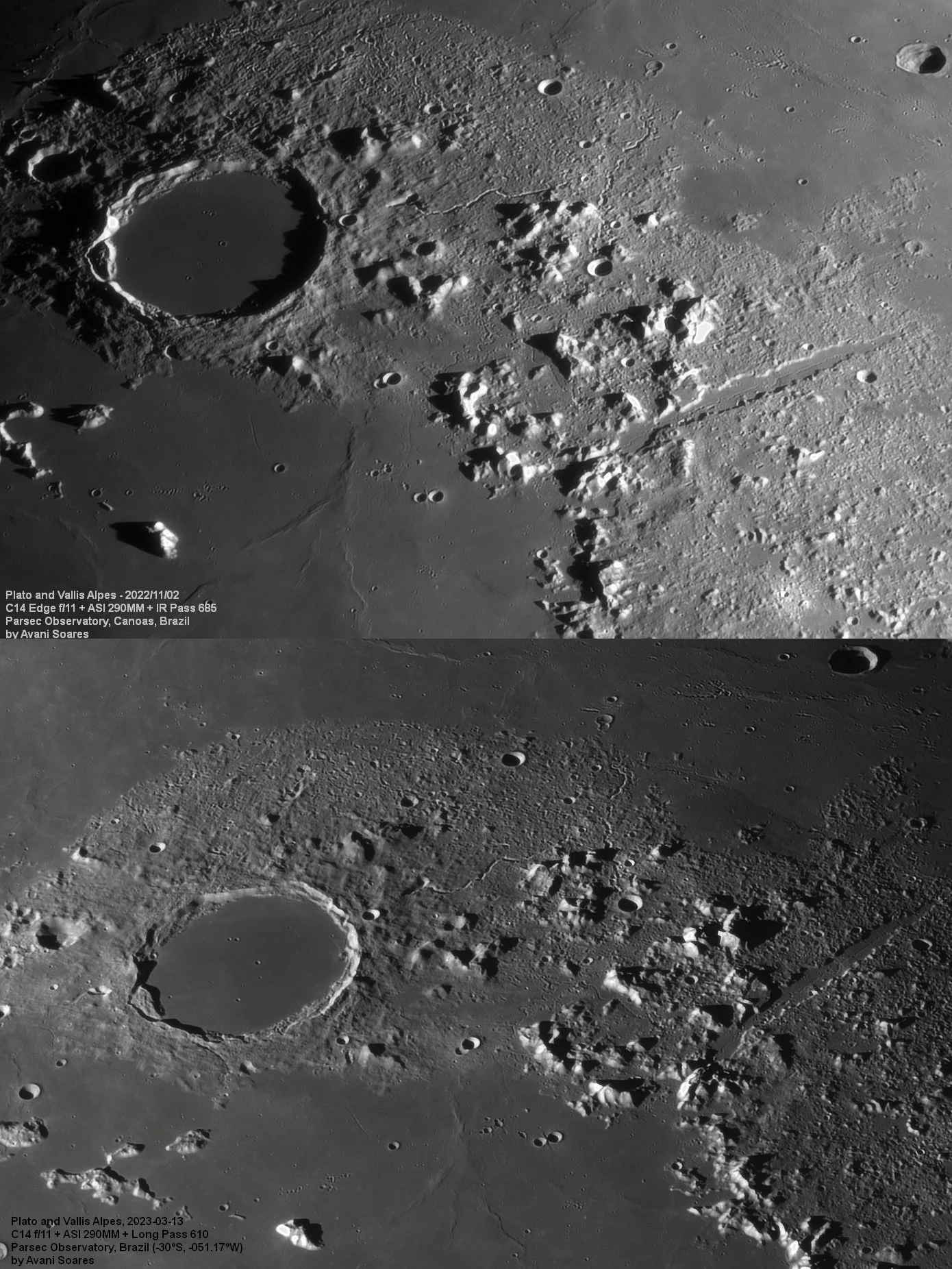Two photos, two moments, the same place!
Image Description and Details : Two photos, two moments, the same place!
How about photographing the same location in completely different lighting angles?
The attached photos were taken 4 months apart and with the sun in exactly opposite positions. In the photo above we have the Sun to the east, rising in Plato and Valiis Alps, the photo below was taken with the Sun to the west, there the Sun is setting in the same region. Photos in these conditions and of such magnitude, sublimely show the differences that the Moon offers us at every moment and show us that one day will never be the same as the other.
Plato is one of the main targets of lunar astrophotography.
A good photo of Plato should show at least 3 or 4 smaller craters present on its floor, always in a darker hue than the surrounding terrain.
But every good self-respecting astrophotographer knows that it's not easy to make these small craters appear on your floor, and for that to happen certain conditions must be met.
Firstly, an opening of no less than 250mm is ideal, not that it is impossible to register them with 200mm or even 180mm, but with 250mm it is much easier.
Secondly, the angle of incidence of sunlight must also be observed, if the terminator is too low and close, the contrast is too great making it difficult to record, if on the other hand the sun is too high, the smaller craters do not form shadows which it also makes it impossible to register them. I believe that the ideal is the Sun at an altitude of 30° to 45° so the contrast is not so great and shadows are still formed, facilitating their perception.
Thirdly, we must pay attention to seeing, with a bad seeing any recording is almost impossible, as these small craters disappear when the turbulence is strong.
Focus I won't talk because any mistake ends with a good result!
As a general rule, in order to get an impressive photo of at least some of these small craters, they would have to be briefly visible during real-time computer screen capture. If so, we learned that after the best stacked frames, these small craters will show up perfectly as seen in the attached photo.
Vallis Alpes, in the south of Mare Frigoris, not far from Cassini crater and Plato's Great Eastern Plain, is one of the most spectacular valleys on the moon.
Seen in this image, Vallis Alpes (Alpine Valley) is a feature that extends 166 km from Mare Imbrium, running northeast to the edge of Mare Frigoris. This valley was discovered in 1727 by Francesco Bianchini. The valley is narrow at both ends and widens in the center to be about 10 kilometers in diameter.
The bottom of the valley has a flat, lava-flooded surface with a narrow 'channel' winding through the middle. This channel is generally thought of as a "graben", an area between two parallel faults that have fallen below the surrounding area. The narrow inner channel is believed to have formed after the formation of the Imbrium basin, after the lava flows into the sea. It probably corresponds to a 'lava tube' that collapsed in a later geological episode due to the high velocity and low viscosity of the magma.
It is very interesting to know that channels are common on the moon, considered one of the most fascinating volcanic features due to their wide range of scales (from 100 meters to over 100 km in length) and the morphologies they present (linear, curved or sinuous). .
Channels typically form when lava flows erode the existing surface, melting the substrate, removing mechanical material, or a combination of thermal and mechanical processes. However, some may have been lava tubes, rilles, that suffered roof collapse after their formation.
Trying to detect this relatively narrow and winding channel that runs along the bottom of Vallis Alpes is one of the favorite challenges of lunar observers, its exact dimensions have not been determined, but its vision is a very satisfactory test, as are the small craterlets on the Plato floor. .
I hope these tips are of some use to anyone like me who likes to venture into lunar photography!
PS: The bottom photo is just a result of stacking in AS!3 with a sharpness of 60% and nothing else. There is no post processing, Registax, Astrosurface, Photoshop or any other editing program was not used, nor was brightness or contrast adjusted. I've been developing a capture line on lunars for years to avoid any post processing as much as possible, I'm almost there.
Avani Soares (Astroavani)
Copyright: Astroavani
AAPOD2 Title: Two photos, two moments, the same place!
AAPOD2 Page Link: https://www.aapod2.com/blog/iqkrnbzq44pf5fdlqxk5xfvfmomkvl
Submit Your Photo!


